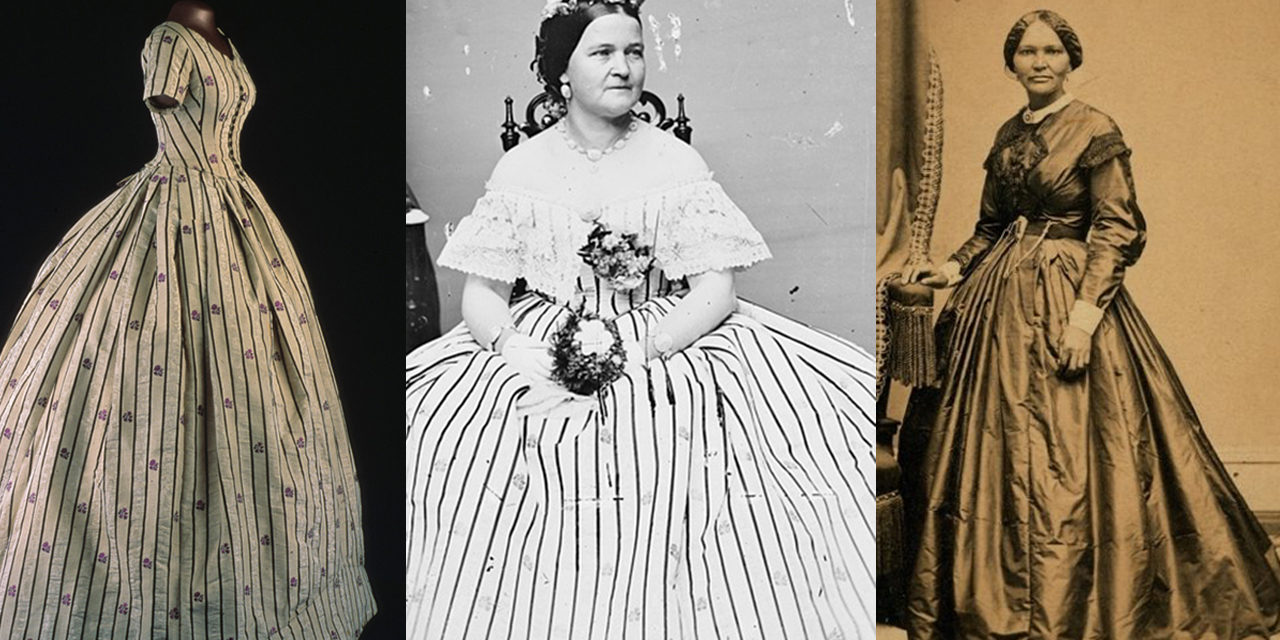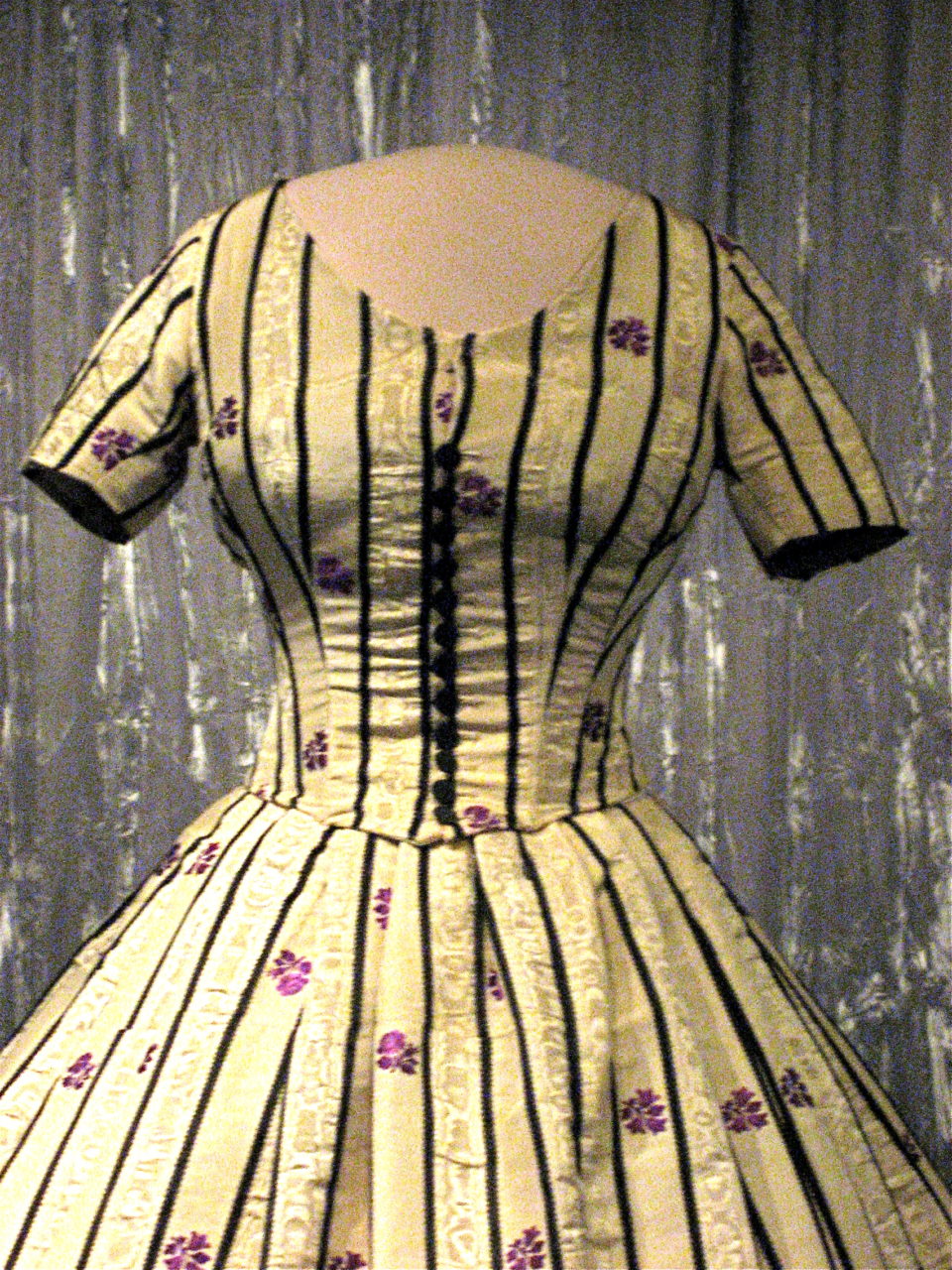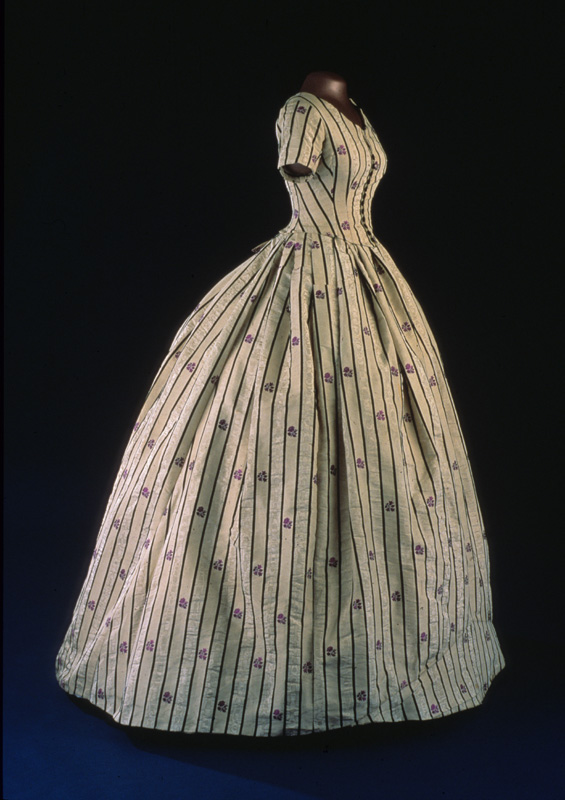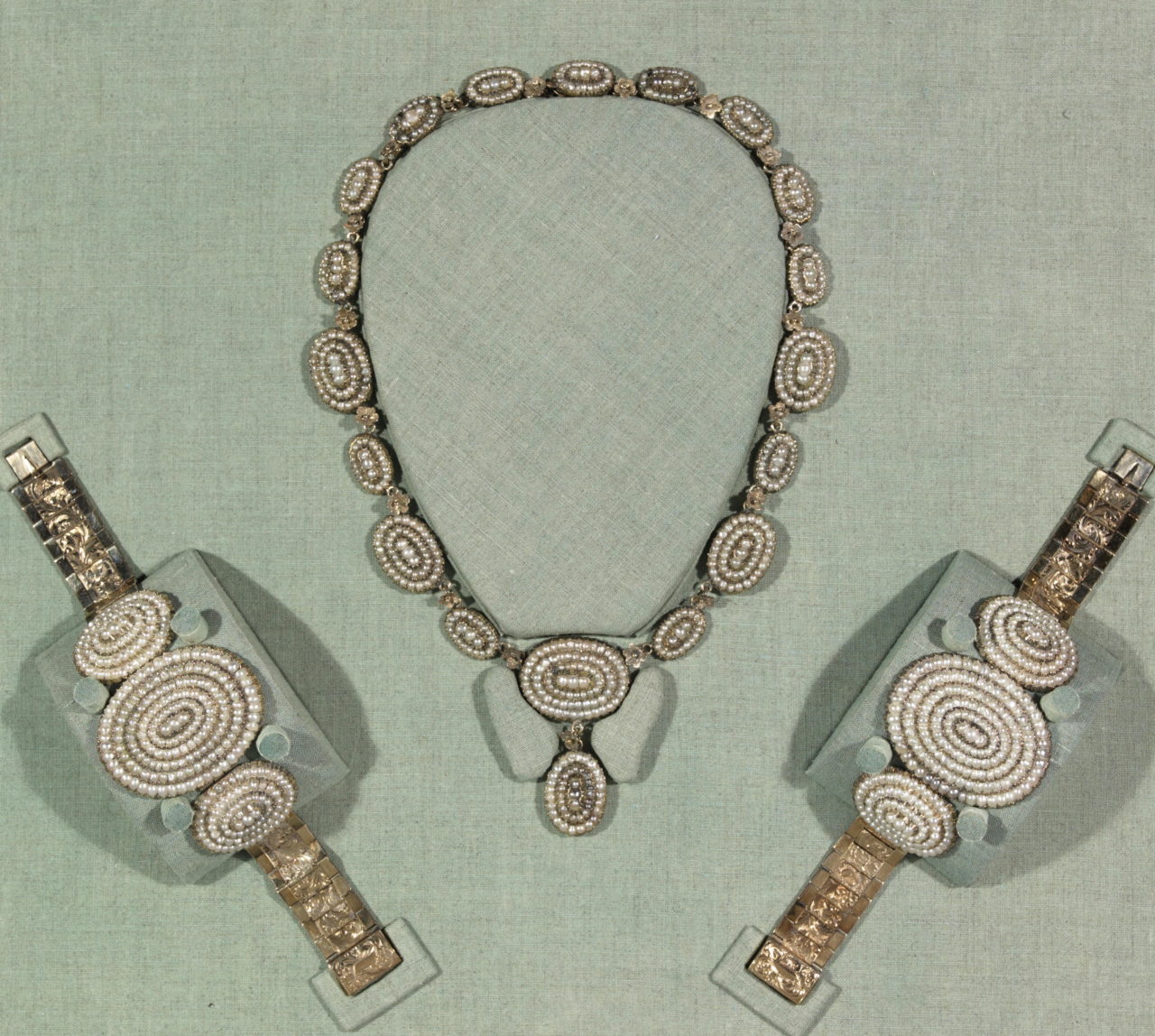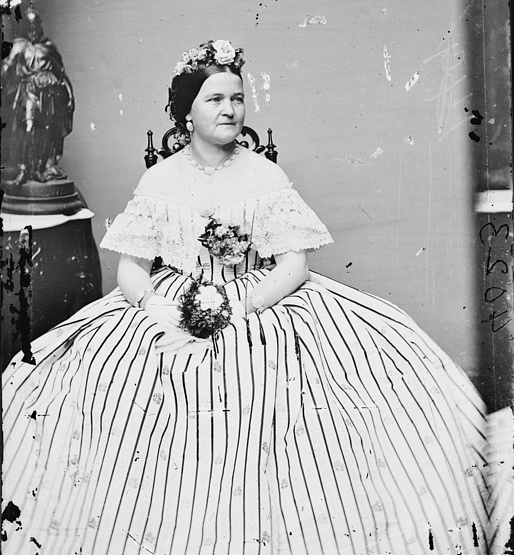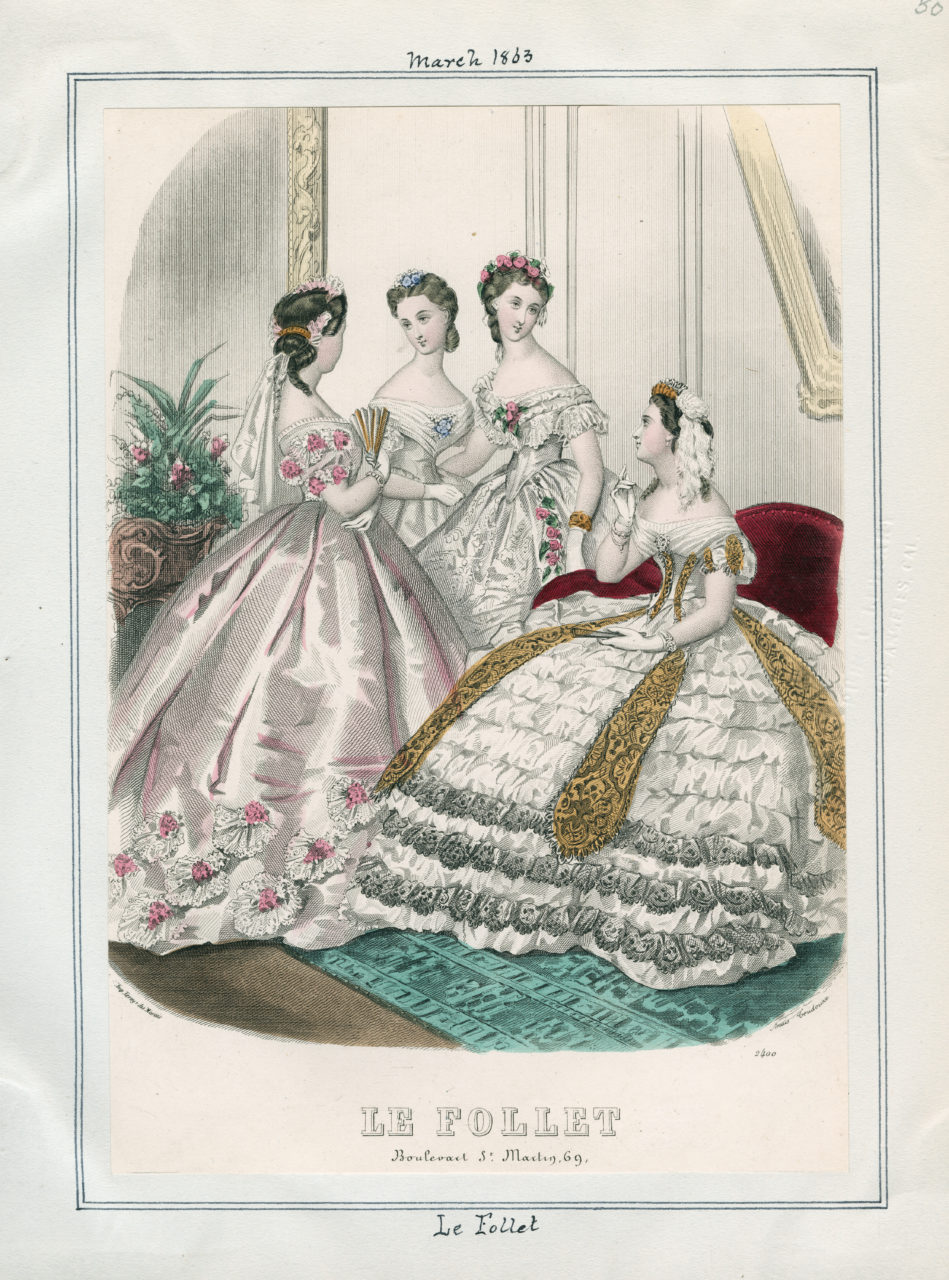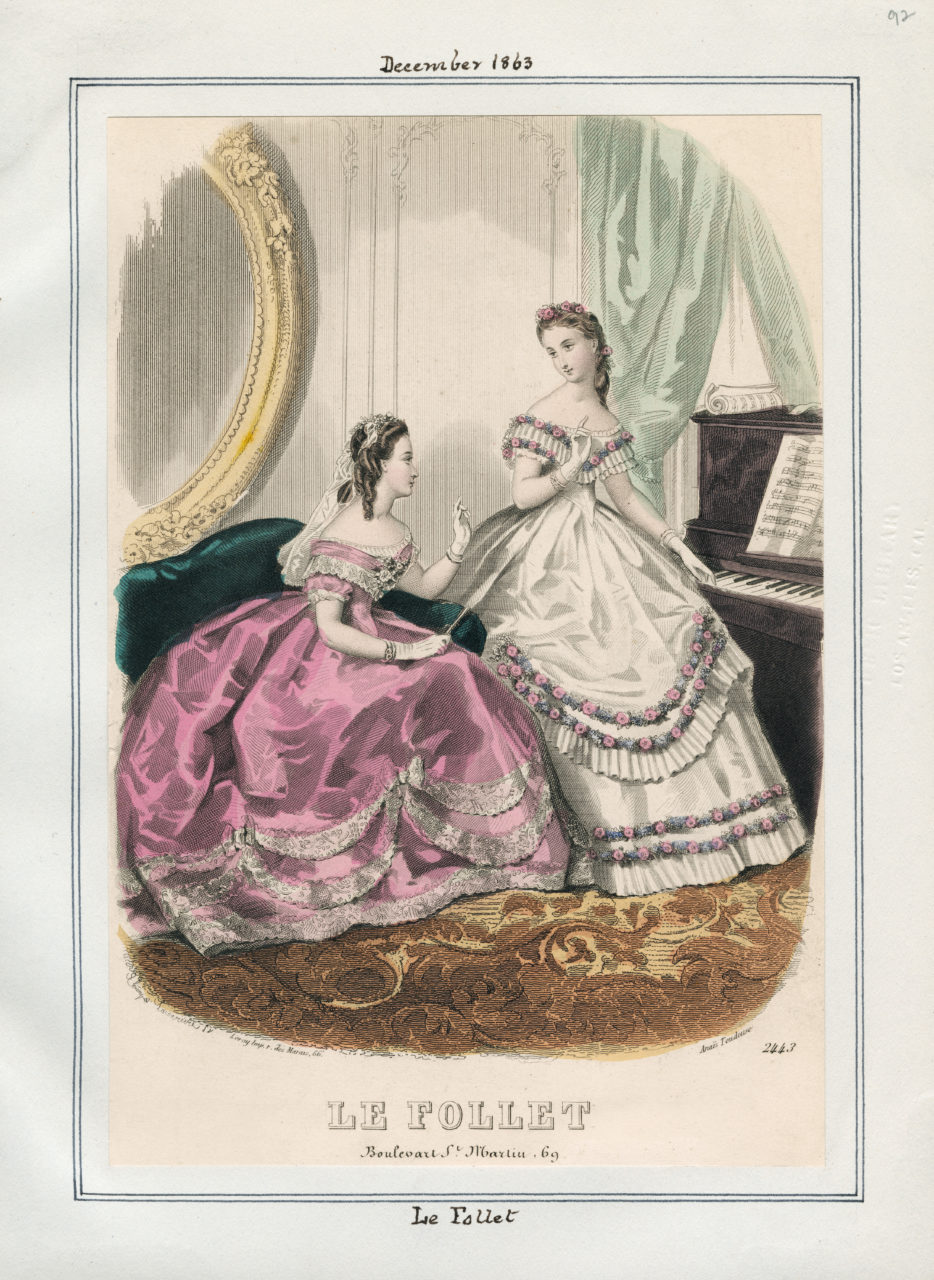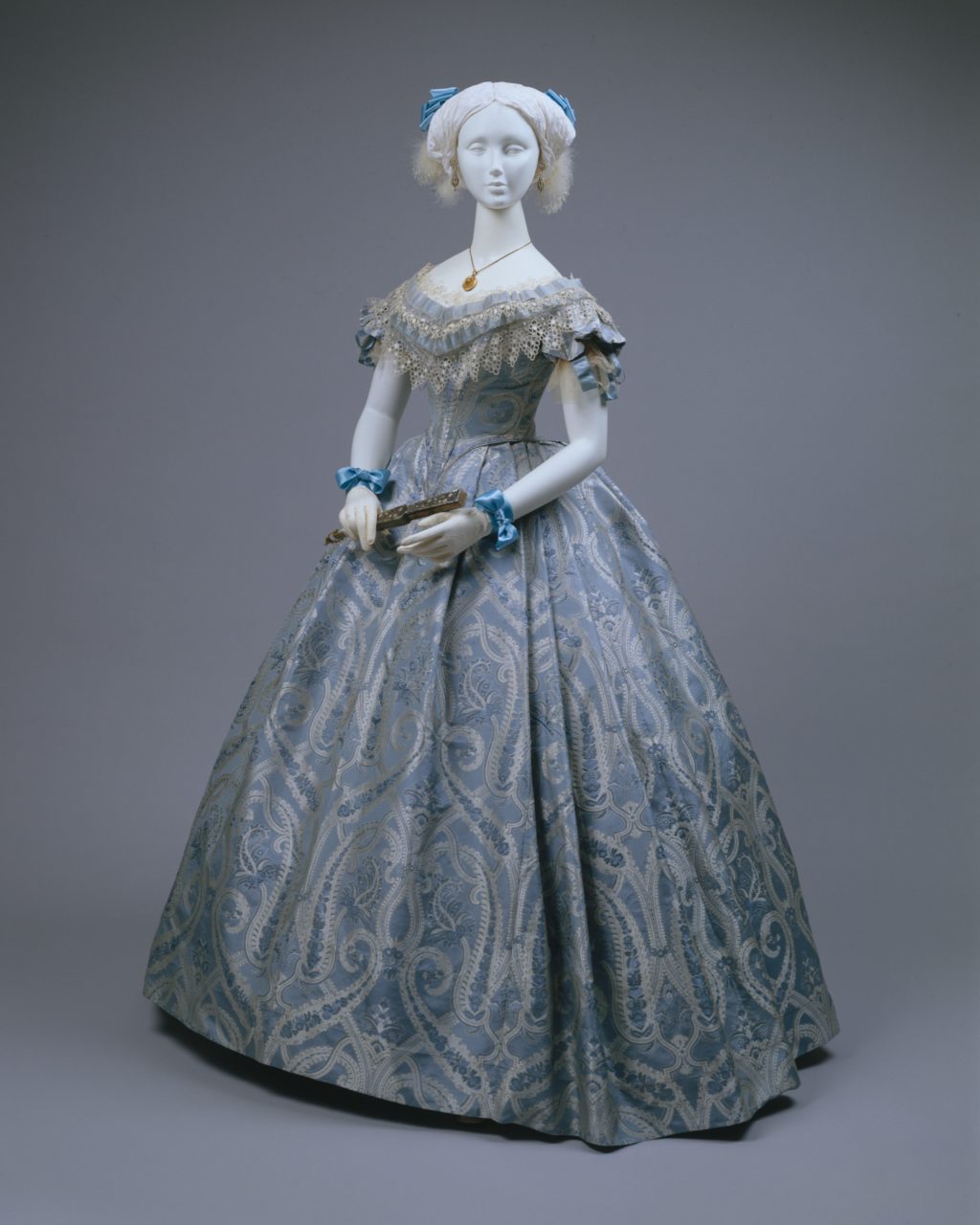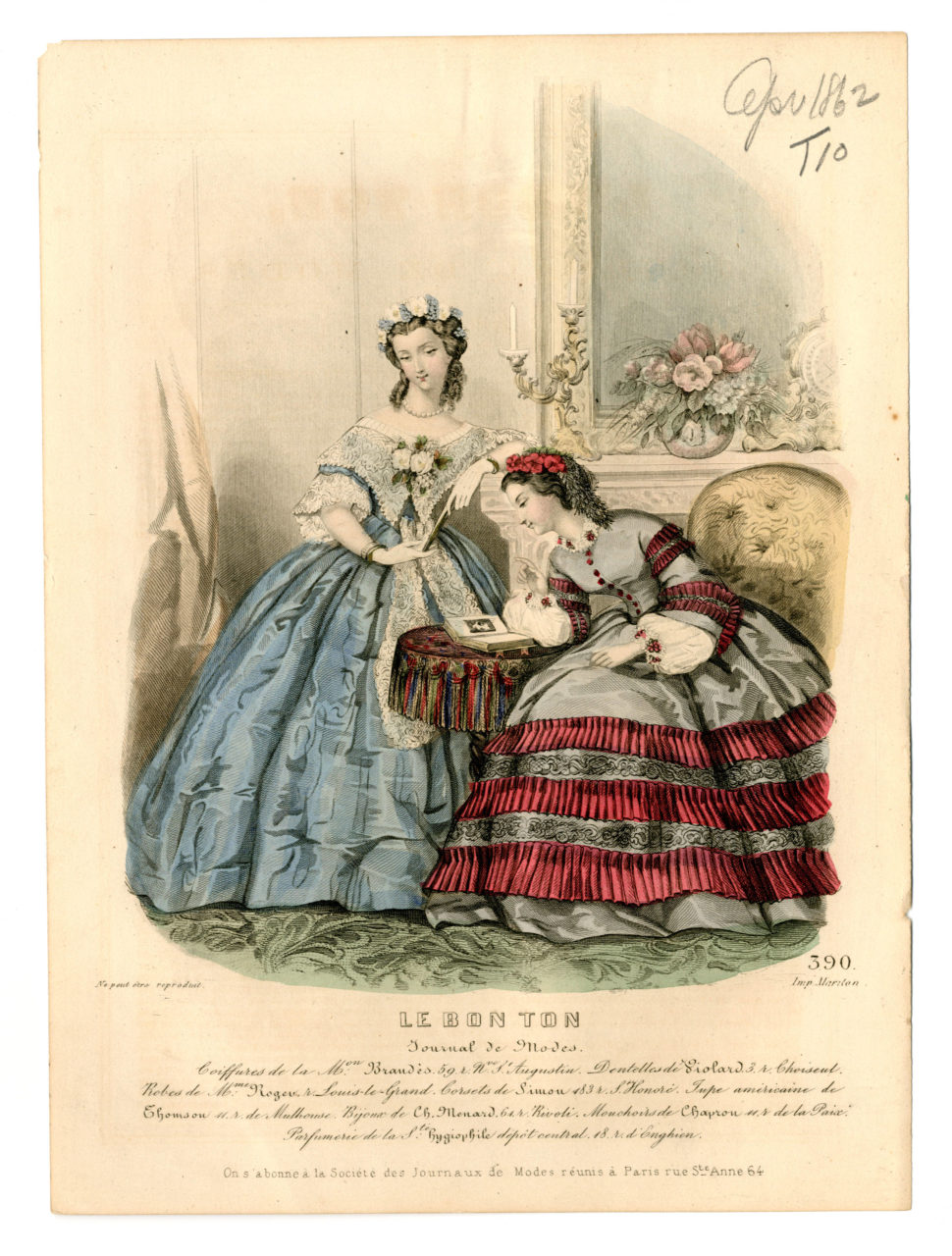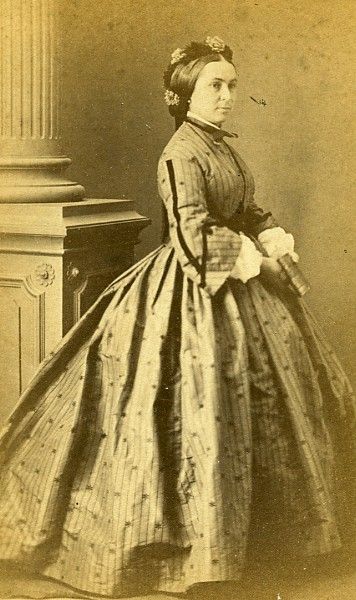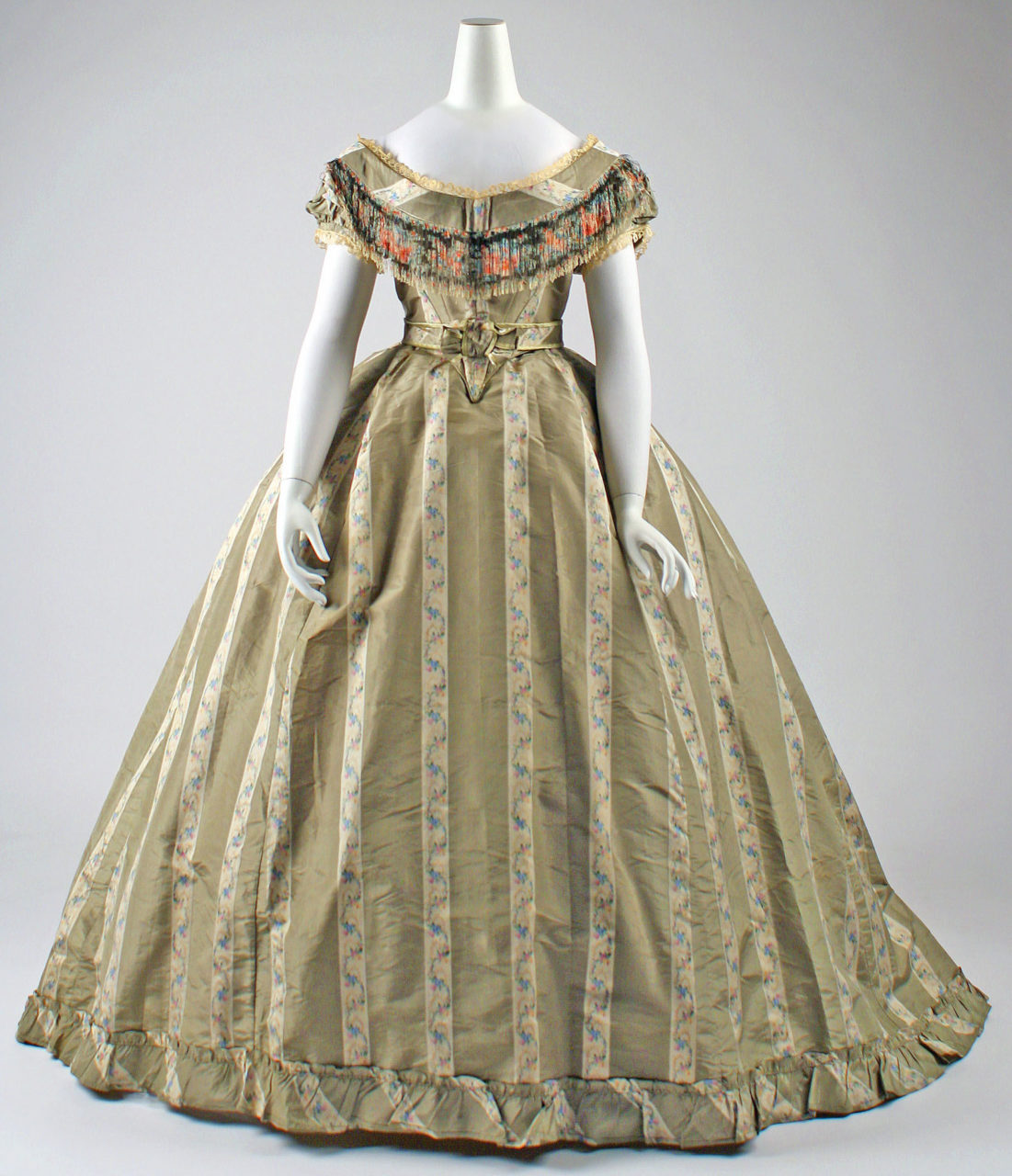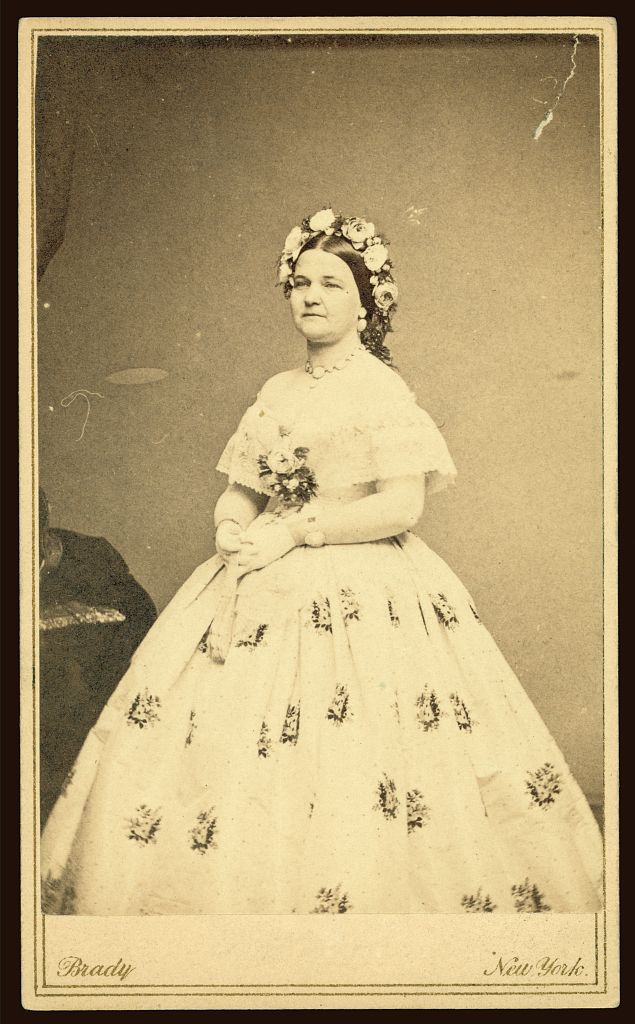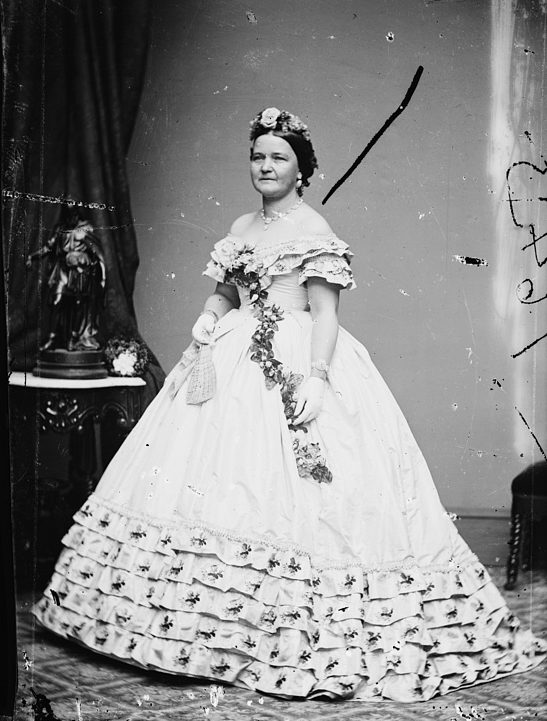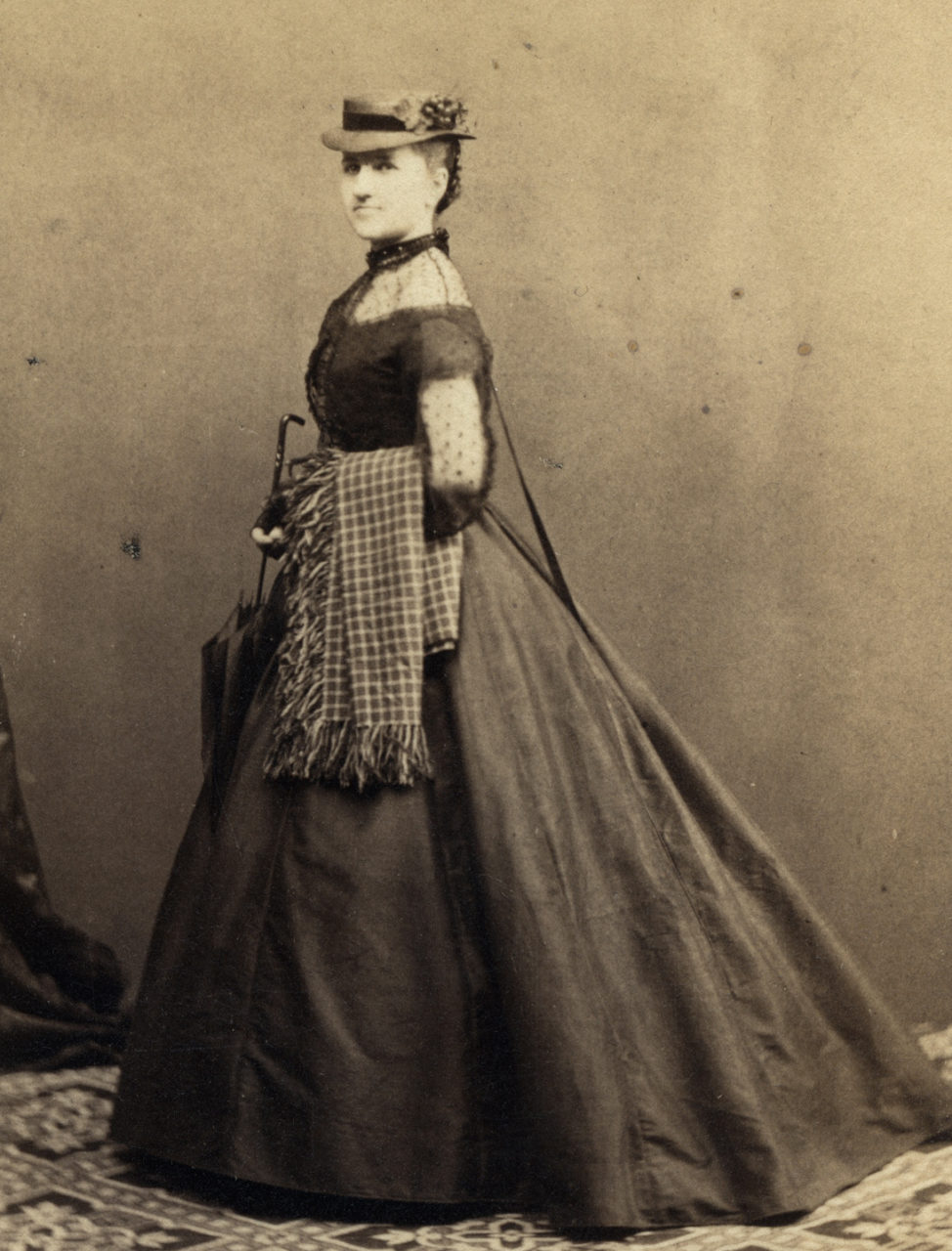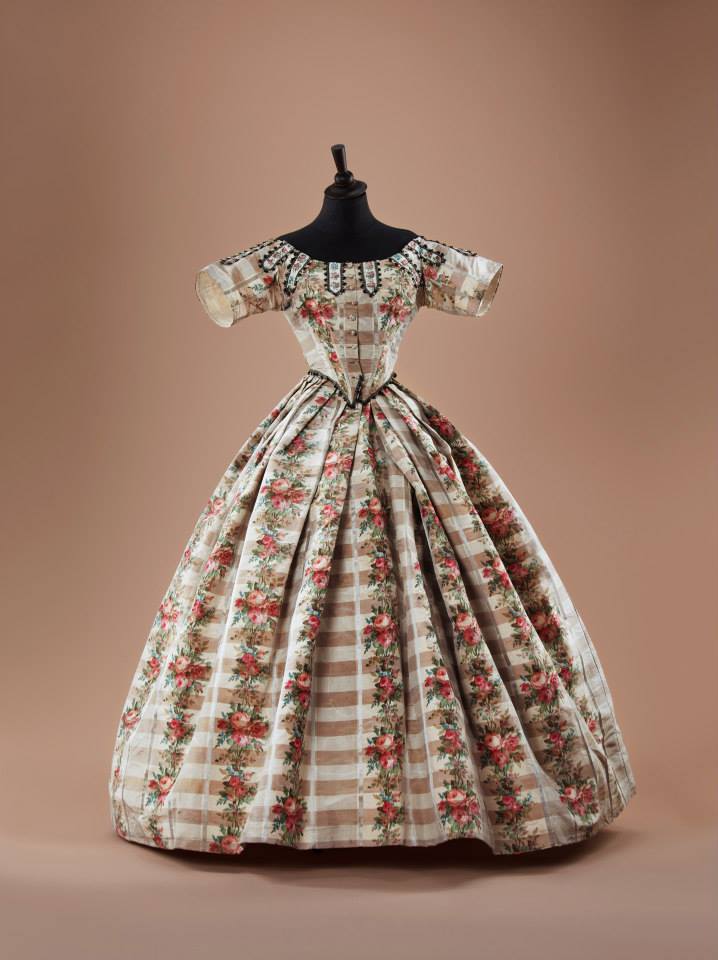This 1863 gown, worn by Mary Todd Lincoln, is an exquisite example of fashionable dress from the early 1860s. With its elegant fabric and thoughtful details, it reveals more about the wearer and the creator, Elizabeth Keckley, an accomplished seamstress who is integral to the history of African-American fashion.
About the Look
Mary Todd Lincoln’s ensemble from ca. 1863 is an excellent example of fashionable dress from the early 1860s. Its waistline sits at Lincoln’s natural waist and comes to a gentle point at the center front. A lace bertha collar elegantly wraps around her shoulders, leaving her décolletage exposed for an evening occasion. It has a wide pleated skirt, worn over a crinoline to achieve an early 1860s bell silhouette. The dress is made from a moiré silk taffeta with brocaded sprigs of magenta flowers set between narrow black stripes (Figs. 1-2).
The dress was created by Elizabeth Keckley, a talented seamstress who was born into slavery in 1818 Virginia. Later in life, she built a thriving dressmaking business in Washington D.C. It is unlikely that the dress was created solely by hand, as an early sewing machine that belonged to Keckley is in the collection at the Chicago History Museum (Benson and Sanders).
As seen in the photograph below, Mary Todd Lincoln complemented the dress with bunches of flowers: as a corsage, as a headpiece, and carried as a small bouquet. Lincoln also pairs the dress with a set of jewelry made with seed pearls (Fig. 3). While the Library of Congress dates the photograph as being from the years 1855-1865, the presence of these jewelry pieces further cements the year in which the dress was worn as The Library of Congress also holds a receipt for their purchase by President Abraham Lincoln in 1862.
In the late 1860s, the dress was altered significantly. This most likely occurred after March of 1867 when Mary Lincoln attempted to divest herself of her collection of dresses (Keckley). The next wearer removed the bertha collar and recut the bodice from fabric in the skirt (Figs. 1,2). The resulting dress had a narrower silhouette and closed in the front with buttons. The waist was reshaped into a straight line that sat slightly lower on the wearer’s body.
Fig. 1 - Elizabeth Keckley (American, 1818-1907). Evening dress for Mary Todd Lincoln, April 1862. Moiré silk taffeta. Washington D.C.: Smithsonian Institution. Source: Flickr
Fig. 2 - Elizabeth Keckley (American, 1818-1907). Evening dress for Mary Todd Lincoln, April 1862. Moiré silk taffeta. Washington D.C.: Smithsonian Institution. Source: National Museum of American History, Behring Center
Fig. 3 - Tiffany (American). Seed-Pearl Necklace and Matching Bracelets, April 1862. Washington D.C.: Library of Congress. Library of Congress, Rare Book and Special Collections Division, Alfred Whital Stern Collection of Lincolniana.. Source: Library of Congress
Mrs. Abraham Lincoln, 1855-1865. 1 negative: glass, wet collodion. Washington: Library of Congress, LC-BH82- 4023 B [P&P]. Source: Library of Congress
About the Maker
Elizabeth Keckley (Fig. 4) was known to be a skillful businesswoman, and a close confidant of Lincoln (Way, “The Story of Elizabeth Keckley”). She was born into slavery in Virginia and was passed amongst owners, several of whom were her white half-siblings. As an adult, she was brought to Saint Louis, Missouri. There, she worked as a dressmaker to support the family who owned her until she was able to raise enough money to purchase her and her son’s freedom (Keckley).
Afterward, she moved to Washington and built a highly successful business creating clothing for wives of the political elite. It was then that she befriended First Lady Mary Lincoln, for whom she eventually created 15-16 dresses every season (Way, “The Story of Elizabeth Keckley”). [Read about another of her designs for Keckley, an 1861 purple velvet day and evening dress here]. Keckley’s dressmaking was in high demand; at one time, she employed twenty seamstresses (Wartik).
She was one of the first African-American women to publish a book (Wartik). Her autobiography entitled, Behind the Scenes, or, Thirty Years a Slave, and Four Years in the White House was published in 1868.
Keckley was also a strong advocate for civil rights and the Black community (Giddings and Ray). During the Civil War, she started a relief organization for former slaves searching for refuge in Washington (Wartik). In her book, she included correspondence between herself and Frederick Douglass.
Keckley’s work, along with the work of other designers of the late 19th century such as Louvinia Price and Fannie Criss, paved the way for the rise of mainstream African American fashion designers. As written by Elizabeth Way, fashion historian and a curator at the Museum of FIT:
“[Transitional African American designers] were then able to choose their own clients, earn significant profits by their design and technical talents, and hire assistants to form workshops. Their success carved out an ever growing space in the American fashion industry for black designers and facilitated their expanding participation in mainstream fashion design throughout the late twentieth century.” (124, “Elizabeth Keckley and Ann Lowe”)
Fig. 4 - Photographer unknown. Elizabeth Keckley, ca. 1861. Washington D.C.: Moorland Spingarn Research Center at Howard University. Source: The White House Historical Association
About the context
Mary Lincoln, who was born in Kentucky, was not well received by Washington society. Politicians believed that she was uncultured, and possibly even a Confederate sympathizer (Landreth). As a result of this, Lincoln fought hard to improve her reputation; wearing extravagant clothing and hosting lavish dinners. Keckley describes her early impressions of Lincoln:
“I was surprised at her grace and composure. I had heard so much, in current and malicious report, of her low life, of her ignorance and vulgarity, that I expected to see her embarrassed on this occasion. Report, I soon saw, was wrong. No queen, accustomed to the usages of royalty all her life, could have comported herself with more calmness and dignity than did the wife of the President. She was confident and self-possessed, and confidence always gives grace.” (89)
This ca. 1863 dress exemplifies this attitude. It adheres to the fashions of its year, showing off new trends in silhouettes as well as textiles.
Evening gowns with lace bertha collars and pointed waistlines that bear a striking similarity to Lincoln’s dress are commonly found in contemporary fashion periodicals. Godey’s Lady Book, a popular American women’s magazine, writes in their March 1862 issue, “The pointed bodice once more rules, and is welcomed back by many whom the round waistband gave a dumpy appearance. The best dresses are made with points” (311). This shape of bodice appears multiple times in fashion plates from Le Follet, as seen in figure 5 in the second dress from the right, and figure 6 on the woman on the left. Another example of this style resides at the Metropolitan Museum of Art (Fig. 7), however, Mary Lincoln’s ensemble is significantly more revealing.
The fabric used in the creation of this dress would have been on trend for the year as well. In April 1863, Godey’s Lady Book raves about this style of moiré taffeta, in which they describe it as “moirée chinée”:
“Quite as chaste as the crocuses are the tiny chineé patterns in delicate spring tints, on a plain mauve, stone, or cuir ground, or that indefinite pinkish, purplish shade, the exact counterpart of our emblematic flower. Then again, and newer still, we have the same design and colors on a moiré ground- moiré chinée, and entirely new composition.” (407)
As far as the moiré texture itself, in 1863 Godey’s Lady Book calls it “very much worn” (105) in January, and in April notes “the rich yet delicate effect of these wonders of the loom” (407), as well as its magnificent appearance when worn by a member of the British aristocracy in September (284). Moiré can also be seen in this 1862 fashion plate from Le Bon Ton (Fig. 8).
A similar floral-patterned taffeta can be seen in figure 9, a gown from ca. 1862. The fabric of both dresses show delicately silhouetted flowers, which have a gentle contrast against cream-colored backgrounds. More of this style of jacquard is featured in figures 10 and 11.
Fig. 5 - Adele-Anaïs Colin Toudouze (French, 1822-1899). Le Follet, Volume 43, Plate 30 (March 1863). Los Angeles: Casey Fashion Plates, rbc5081. Source: Digital Collections of the Los Angeles Public Library
Fig. 6 - Adele-Anaïs Colin Toudouze (French, 1822-1899). Le Follet, Volume 43, Plate 92 (December 1863). Los Angeles: Casey Fashion Plates, rbc5143. Source: Digital Collections of the Los Angeles Public Library
Fig. 7 - Maker unknown (probably American). Ball gown, ca. 1860. Silk, cotton. New York: Metropolitan Museum of Art, 1983.479.1a–c. Gift of Mrs. Frederick van Beuren Joy, in memory of Mrs. Jacob Harsen Halsted, 1983. Source: Metropolitan Museum of Art
Fig. 8 - Artist unknown (French). Le Bon Ton, pl. no. 390 (1862). New York: Metropolitan Museum of Art, b17509853. Gift of Woodman Thompson. Source: Metropolitan Museum of Art
Fig. 9 - Maker unknown (American). Ball gown, 1861-1862. Silk. Private Collection. Source: Pinterest
Fig. 10 - Maker unknown. Day dress, 1860-1870. Source: Pinterest
Fig. 11 - Maker unknown (British). Ensemble, ca. 1865. Silk. New York: Metropolitan Museum of Art, 1983.27.1a–d. Purchase, Irene Lewisohn Bequest, 1983. Source: Metropolitan Museum of Art
This pattern can also be seen in figure 12, in the Journal des jeunes personnes. Although the textile appears in a fashion plate depicting junior’s clothing, it is known that Lincoln had a penchant for styles that were seen as being too youthful for her (Way, “Elizabeth Keckley and Ann Lowe” 128). Keckley balanced Lincoln’s ostentatious aesthetic with her own preference for clean lines (Way, “Elizabeth Keckley and Ann Lowe” 128).
With her choice of accessories, Mary Todd Lincoln continued to show her awareness of contemporary trends. Keckley mentions in her autobiography that Lincoln has a penchant for wearing flowers (88). This would have been a fairly common practice for the year. Women wearing flowers on their dresses and in their hair can be seen in figures 6, 8, and 9.
The glinting pearls worn by Lincoln can also be seen in other photographs of her. She wore them to her husband’s inaugural ball (Fig. 13), and again on a separate occasion (Fig. 14). The set held by the Library of Congress only includes bracelets and a necklace, however, Lincoln can be seen wearing matching earrings too.
It is unclear when the dress was altered, but Lincoln likely divested herself of it after 1867. As Keckley discusses in her book, Lincoln was attempting to rectify a tremendous amount of debt from her years of wearing elaborate clothing and hosting extravagant parties (149-150). After the death of her husband, Lincoln solely wore mourning dress (365), and would no longer have use for cream-colored ball gowns. It can be assumed that the dress was altered after it left her possession. The gown in its current state bears some similarity in shape to others from the latter part of the decade (Figs. 15, 16). However, it has a conspicuous lack of detail, which would have been inappropriate for an evening dress.
What is known about the dress, however, is that it reveals a broader story about Elizabeth Keckley and Mary Lincoln. With its silhouette, careful use of textiles, and Lincoln and Keckley’s choices in styling, the dress displays multiple popular trends of 1863. It is an excellent example of Keckley’s knowledge of fashion and attention to detail. Paired with insights from its maker, this gown can show more about Mary Lincoln’s relationship with clothing and society.
Fig. 12 - Héloïse Leloir (French, 1819-1873). Journal des jeunes personnes, August 1862. New York: Metropolitan Museum of Art, b17509853. Gift of Woodman Thompson. Source: Metropolitan Museum of Art
Fig. 13 - Mathew Brady (American, 1823-1896). Mary Todd Lincoln, 1861. Albumen, on carte de visite mount. Washington D.C.: Library of Congress, PR 13 CN 1972:018 [P&P]. Brady-Handy photograph collection, Library of Congress, Prints and Photographs Division. Source: Library of Congress
Fig. 14 - Maker unknown (American). Mrs. Abraham Lincoln, [between 1855 and 1865]. Glass, wet collodion. Washington D.C.: Library of Congress, LC-BH82- 4023 [P&P]. Brady-Handy photograph collection, Library of Congress, Prints and Photographs Division. Source: Library of Congress
Fig. 15 - Ede Kozics (Hungarian, 1829-1874). Pozsony 1860s, 1860-1870. Source: Flickr
Fig. 16 - Maker unknown. 1860s Evening dress, 1860-1870. Alexandre Vassiliev. Source: Facebook
Its Afterlife
The gown, as well as images of Mary Lincoln wearing the original version, have been displayed at the Smithsonian Institute in their First Ladies gallery, which closed in 2011 (National Museum of American History).
An iteration of the dress (Fig. 17) was featured in the Oscar-nominated film, Lincoln, which was released in 2012. For the movie, costume designer Joanna Johnston drew inspiration from Keckley’s original design for the clothing worn by Sally Field as Mary Lincoln (Vanity Fair).
Fig. 17 - Joanna Johnston (English). Sally Field as Mary Lincoln, 2012. Source: Vanity Fair
References:
- Benson, Samii Kennedy, and Eulanda A Sanders. “From Enslavement to Entrepreneurship: Elizabeth Keckley Designer and Dressmaker.” Iowa State University Digital Repository, November 8, 2016. https://doi.org/10.31274/itaa_proceedings-180814-1431.
- “Chitchat Upon New York and Philadelphia Fashion for March”
Godey’s Lady Book vol. 64, 20. (March, 1862): https://books.google.com/books?id=-YBMAAAAMAAJ&printsec=frontcover&source=gbs_ge_summary_r&cad=0#v=onepage&q&f=false - “Chitchat Upon New York and Philadelphia Fashion for January” Godey’s Lady Book vol. 66 (January, 1863): https://hdl.handle.net/2027/mdp.39015020057520?urlappend=%3Bseq=113
- “Chitchat Upon New York and Philadelphia Fashion for April” Godey’s Lady Book vol. 66, 27. (April, 1863): https://babel.hathitrust.org/cgi/pt?id=mdp.39015020057520&view=1up&seq=405
- Foster, Helen Bradley. “Constructing Cloth and Clothing in the Antebellum South.” New Raiments of Self: African American Clothing in the Antebellum South, 75–133. Dress, Body, Culture. Oxford: Berg Publishers, 1997. http://dx.doi.org/10.2752/9781847888808/NEWRAIM0005.
- Giddings, Valerie L., and Geraldine Ray. “Trendsetting African American Designers.” Berg Encyclopedia of World Dress and Fashion: The United States and Canada, edited by Phyllis G. Tortora. Oxford: Bloomsbury Academic, 2010. http://dx.doi.org/10.2752/BEWDF/EDch3512.
- Hanel, Marnie. “Sketch to Still: How Lincoln’s Sweeping Oscar-Nominated Gowns and Presidential Suits Were Created.” Vanity Fair, January 19, 2013. https://www.vanityfair.com/hollywood/2013/01/lincoln-oscar-nominated-costumes-sally-field.
- Keckley, Elizabeth. Behind the Scenes, or, Thirty Years a Slave, and Four Years in the White House (version University of North Carolina at Chapel Hill). New York, NY: G. W. Carleton & Co., Publishers, 1868. https://docsouth.unc.edu/neh/keckley/keckley.html.
- Landreth, Andrew. “‘Ever True and Loyal:” Mary Todd Lincoln as a Kentuckian.” Murray State University. Murray State’s Digital Commons, 2017. https://digitalcommons.murraystate.edu/cgi/viewcontent.cgi?article=1569&context=scholarsweek.
- “Paris Correspondence” Godey’s Lady Book vol. 67, 19. (September, 1863): https://babel.hathitrust.org/cgi/pt?id=mdp.39015020057520&view=1up&seq=854
- “The First Ladies: Introduction.” National Museum of American History. https://americanhistory.si.edu/first-ladies/introduction.
- Wartik, Nancy. “Overlooked No More: Elizabeth Keckly, Dressmaker and Confidante to Mary Todd Lincoln.” The New York Times, December 12, 2018. https://www.nytimes.com/2018/12/12/obituaries/elizabeth-keckly-overlooked.html.
- Way, Elizabeth. “The Story of Elizabeth Keckley, Former-Slave-Turned-Mrs. Lincoln’s Dressmaker.” Interview by Emily Spivack. Smithsonian Magazine. Smithsonian Institution, April 24, 2013. https://www.smithsonianmag.com/arts-culture/the-story-of-elizabeth-keckley-former-slave-turned-mrs-lincolns-dressmaker-41112782/.
- Way, Elizabeth. “Elizabeth Keckly and Ann Lowe: Recovering an African American Fashion Legacy That Clothed the American Elite.” Fashion Theory, 19:1, 115-141, DOI: 10.2752/175174115X14113933306905

